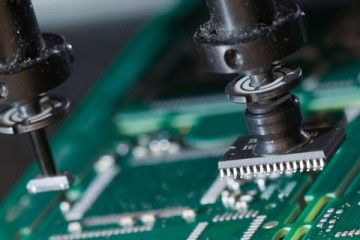In recent years, resin plug holes have become very popular in the PCB industry and have a wide range of applications. Especially some products with high layers and thick boards have a higher use rate of resin plug holes. So what is a resin plug hole? What are the benefits?
What is a resin plug hole?
With the continuous change and reform of electronic chip structure and design methods, circuit board modules have also undergone great changes. With the change of modules, the problem of green oil plugging in electronic chips has deeply troubled many smt processing manufacturers. In order to solve this problem, many pcb engineers have put in research efforts until the 1990s, a Japanese pcb manufacturer invented resin, which can plug this kind of hole, and then plate copper on the surface, which can solve the problem of blowing in the hole caused by the green oil plug hole.
However, the technology promotion at that time was not as rapid as it is now, it is only in recent years that China has started to use resin plugging to operate.

What is the production process of the resin plug hole?
The production process of different resin plug products is different, such as POFV type products, the process is cutting drilling-electroplating-plug hole-baking-grinding-electroplating-outer circuit-solder mask-surface treatment-molding Shipment, etc.; and the production of inner resin plugged products is divided into two types: grinding and non-grinding. The processes of the two are basically the same, but there will be some differences in the details.
There are some special places in the resin plugging process, such as drilling through holes and sinking copper boards, which are generally considered to be POFV products, but if it is an inner layer pattern, it is an HDI resin plugging product, and different types of product processes are very strict You can’t go wrong with the definition standard, otherwise it will be extremely prone to problems.
In terms of resin plugging process improvement, in order to reduce the scrap rate of inner HDI plugging products, designers will adopt the mode of plugging after the line. Firstly, completing the inner line production, then plugging the hole, and then curing, so that not only the efficiency is high, and the product performance is better. In the beginning, the inner HDI plugs were used. UV pre-cured and thermosetting inks were used. This type of ink has low performance, low efficiency, and cost much higher than resin plugs.
In conclusion
In general, a good resin plugging process must be operated by a professional pcb manufacturer. Only by ensuring that the resin plugging is normal can the quality of the product be guaranteed. If the resin plug hole is not done properly and bubbles appear in the hole, it will inevitably cause the circuit board to absorb too much moisture and vapor, and then cause the board to burst due to excessive moisture when it passes through the tin furnace. At the same time, the appearance of air bubbles in the holes can also easily cause the resin to be squeezed out by the pores, and the situation that one side protrudes while the other is recessed, which will form defective products and affect the pass rate of the product.
For pcb manufacturers, it is very practical to use resin plug holes for pcb processing and production. It can not only avoid tin leakage and improve product performance, but also improve production efficiency and bring more returns to enterprises.





